Digikam/Führung
Einführung
Menschen, die digitale Fotografie für ihr kreatives Gestalten verwenden, sind sehr vertraut mit Software-Produkten von Unternehmen wie Adobe ™ , Corel ™ , ACD Systems ™ , Bibble Labs ™ , Lichtwerk™ und sogar Google ™. Die meisten von ihnen sind wahrscheinlich mit Gimp vertraut, was bis vor kurzem die führende Open-Source -Bildbearbeitung war. Leider fehlt Gimp eine sehr wichtige Funktion für viele Fotografen, die 16-Bit pro Kanal Bearbeitung. Aus diesem Grund haben die meisten Profifotografen nicht Gimp als eine praktikable Alternative. Zwar gibt es auch Cinepaint, die sich von Gimp vor ein paar Jahren abgespalten hat, und bietet 16-Bit pro Kanal zur Bearbeitung. Leider lässt seine Schnittstelle eine Menge zu wünschen übrig, und scheint nicht umfassen gepflegt zu werden.
Glücklicherweise gibt es jetzt eine weitere Open-Source-Alternative mit 16-Bit- Modus als Bearbeitungsfunktionen, die wie es aussehe die großen Jungs hinter ihrem Geld nachlaufen lassen könnte - . Ich persönlich habe digiKam erst vor kurzem entdeckt. Vorher hatte ich es auch schon versucht , aber erst seit der KDE SC 4 Edition denke ich, war es bereit für meinen Einsatz. Ich war eigentlich ziemlich überrascht zu sehen, wie sehr sich digiKam verbessert hat und wie viele Funktionen es beinhaltet. Einige seiner Eigenschaften sind:
- 16 bit Unterstützung pro Kanal.
- Kurven und Gradationswerkzeuge.
- Farbmanagementunterstützung
- Weißabgleich mit Farbtemperaturpipette
- Linsenkorrektur für Objektivfehler
- Nach Seitenverhältnis zuschneiden mit verschiedenen Standardformaten.
- Ordentlicher Schwarzweißkonvertierung
- Stapelverarbeitung
- Stichwörter und Suchfunktionen
- Export nach Facebook, Flickr, Picasa, etc.
Und es gibt noch viel viel mehr, dass ich einfach keine Zeithabe, um selbst alle zu erwähnen. Natürlich digiKam ist nicht perfekt. Und es gibt ein paar Punkte, bei denen die ich erwarte, dass diese bald verbessert oder korrigiert werden. Aber ich versichere Ihnen, dass, wenn Sie Fotografieren, Sie viel in Zukunft über digiKam zu hören bekommen, hoffentlich genießen Sie die Verwendung von digiKam.
Ich erlaube mir Ihnen in mit einer kurzen Führung zu zeigen wie es ist mit digiKam zu Arbeiten. Derzeit verwende ich digiKam Version 1.0.0-beta4 wie sie in PCLinuxOS KDE4 Repositories vorhanden ist.
Rohdateien bearbeiten
Für diese Tour habe ich beschlossen, dieses Foto zu verwenden, weil es in unterschiedlichen Bereichen über- und unterbelichtet ist.

Dieses RAW Bild habe ich mit meiner alten Pentax istDs* aufgenommen. So schaut es in digiKam Editor aus, welcher auch als eigene Applikation zur Verfügung steht, genannt showFoto.
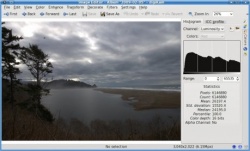
Wenn sie vertraut sind mit Histogrammen, haben sie vielleicht festgestellt dass dieses für dieses Bild etwas seltsam ist. Die Ursache dafür ist, dass digiKam zwei verschiedene Diagrammtypen zeigen kann, ein lineares und ein logarithmisches. Das hier gezeigte ist ein logarithmisches Histogramm, die meisten sind jedoch lineare gewohnt. Mit den Knöpfen über dem Histogramm kann man zwischen den beiden Darstellungen umschalten. Unglücklicher Weise bekommt man dann für dieses Bild eine flache Linie. Die digiKam Dokumentation beschreibt dies so:
“Für Bilder, deren wesentliche Bereiche konstante Farben enthalten, stellt ein lineares Histogramm oft einen einzigen Balken dar. In diesem Fall ist eine logarithmische Histogramm oft sinnvoller.”
Ich bin sicher, dass es dafür technische Gründe gibt, aber ich frage mich, warum andere Programme, wie Cinepaint, in der Lage sind, eine lineare Histogramm für dieses Bild ganz gut zu zeigen. Ich erwähne das, weil ich weiß, dass einige Leute sich auf das Histogramm verlassen und ich denke, dass die lineare Art der Darstellung nützlicher ist. Aber ich stimme zu, dass es mit dem logarithmischen Histogramm besser ist als nichts. Da dies nicht wirklich ein Vorstellung unterbricht, gehen wir weiter.
Ich bin bei weitem kein Nachbearbeitungsexperte. Mein normaler Arbeitsprozess beschränkt sich auf Tonwertkorrektur, Anpassung der Farbsättigung, beschneiden oder Größenänderung und das Schärfen des Bildes. Jetzt versuchen wir es mit diesem Bild.
Tonwertkorrektur
Als erstes verwenden wir die Tonwertkorrektur, welche unter gefunden wird.
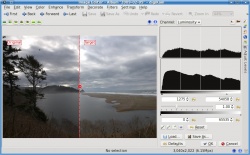
Grundlegend habe ich nur den Kontrast ein wenig erhöht durch das verschieben des linken Anschlagregler (unter dem zweiten Histogramm) nach rechts und des Rechten nach Links. Das Vorschaufenster passt sich automatisch an meine Einstellungen an, so dass ich das Ergebnis vorab sehe.
Farbsättigung
Now, lets increase the saturation to try to bring out the color a little. For that we use the saturation tool found under .
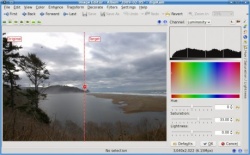
Ich mag diese "Disney" ähnlichen Bilder der Schnappschußkameras mit den stark gesättigten Farben nicht. Ich mag es meine Bilder in ihrem realistischen Erscheinen zu belassen. Ich mag es nicht die Sättigung zu sehr anzuheben. Ich finde, dass für dieses Bild, die Menge an Sättigung genau richtig ist, um ihm Lebhaftigkeit zu geben ohne in ein Comic abzugleiten.
Zuschneiden
Now I am going to crop the image. This is really an important step if you are planning on printing the image. If you have ever taken your DSLR images to be printed without cropping them first, you may have been unpleasantly surprised by the fact that they were not centered correctly, or that an important part of the image was left out. The reason for this is that the image you gave them did not have the same proportions as the paper you asked them to print it on. And so they had to crop it for you. To prevent that from happening you need to crop your images to the same proportions of the paper you will be printing on. Yes, that means that you will need a different image if you want to print 8×10 than if you want 5×7, 14×20, etc. Fortunately, digiKam makes this step a breeze with its aspect ratio crop tool found under .
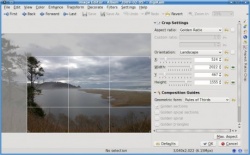
Wie sie sehen können habe ich mich für die "Goldenerschnitt" Option bei diesem Bild entschieden, aber digiKam hat vordefinierte Einstellungen für alle möglichen handelsüblichen Papierformate, und erlaubt außerdem noch benutzerdefinierte Verhältnisse wenn sie es wünschen.
Schärfen
The final step in my photo processing work-flow is to sharpen the image. I am used to using the method for this purpose, but in reading digiKam’s documentation I was surprised to learn that they actually recommend the method as a way to obtain better results. This is how the Sharpen tool looks, found under .
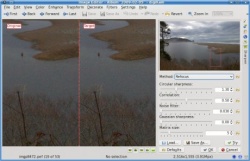
As you can see, you can change the sharpening method used with a drop down button. You can zoom in to the image as much as you want using the button, and you can move the zoom window around in the small preview image above the settings area. I was conservative in the amount of Circular sharpness specified because I could see in the preview area that going for more would result in a lot of grain being visible. This amount improved the sharpness significantly while still retaining the smooth look of the overall image. This is my final result.

Wie Sie sehen können, gibt es einiges an Verbesserung gegenüber dem, womit wir angefangen haben.
Automatische Korrektur
Normally I would have been content with leaving it at that. But since I am still in the exploring digiKam mode, I decided to test some of the tools available. To do that, I went back to the original RAW image, and after importing it, I went straight into . This is what it looks like.
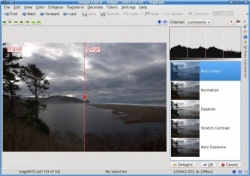
As you can see, there are five automatic correction levels that you can choose from to improve your image. In most images that I have tried this with, the option gives the best results. However, in this particular image the result was too dark. I had not seen any image for which the option resulted in an improvement, but for this particular image the results it gave me were surprisingly good. This is what the digiKam documentation says about the method of :
"Equalize: this method adjusts the brightness of colors across the selected image so that the histogram for the Value channel is as flat as possible, that is, so that each possible brightness value appears at about the same number of pixels as each other value. Sometimes Equalize works wonderfully at enhancing the contrasts of an image. Other times it gives garbage. It is a very powerful operation, which can either work miracles on a image or destroy it."
Well, looks like they were not kidding. My image turned out much better using this method of correction instead of my normal level adjustment step. This is how the image looks after adding saturation, cropping it, and sharpening it.
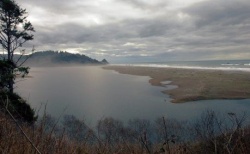
Schlussfolgerung
Without a doubt digiKam has a lot to offer for the photographers among us. Unfortunately, it still has one glaring omission – a clone tool. You may have noticed that the original RAW image had some dust specks in the sky above the trees and in other parts of the clouds. In digiKam, the only tool available for trying to remove such things (other than cropping them out as I did here) is a tool called , found under . However, that tool is not easy to use and is rather slow. With a proper clone tool, as available in most other photo editors, removing such items only takes a few seconds. The good news is that the digiKam developers have acknowledged this omission as a bug and we can expect to see it implemented in a future version of digiKam. In the mean time we can use the Gimp to take care of these items as a final touch up step.
Ich denke, Sie werden mir zustimmen, dass digiKam ein erstaunliches Open-Source -Programm ist. Es ist mittlerweile mein Hauptbildbearbeitungsprogramm. Wenn Sie Fotografieren, ein Versuch ist es wert?
This page was written in October 2009. Can you add to it, talking about a later version?

